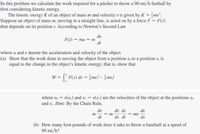
College Physics
11th Edition
ISBN: 9781305952300
Author: Raymond A. Serway, Chris Vuille
Publisher: Cengage Learning
expand_more
expand_more
format_list_bulleted
Concept explainers
Topic Video
Question

Transcribed Image Text:In this problem we calculate the work required for a pitcher to throw a 90-mi/h fastball by
first considering kinetic energy.
The kinetic energy K of an object of mass m and velocity v is given by K = }mv².
Suppose an object of mass m, moving in a straight line, is acted on by a force F = F(s)
that depends on its position s. According to Newton's Second Law
dv
F(s) — та — т
dt
where a and v denote the acceleration and velocity of the object.
(a) Show that the work done in moving the object from a position so to a position sı is
equal to the change in the object's kinetic energy; that is, show that
= [" F(s) ds = }mv?- }mv3
where vo = v(so) and v = v(s1) are the velocities of the object at the positions so
and si. Hint: By the Chain Rule,
dv
dv ds
dv
m
= m
dt
ds dt
ds
(b) How many foot-pounds of work does it take to throw a baseball at a speed of
90 mi/h?
Expert Solution
This question has been solved!
Explore an expertly crafted, step-by-step solution for a thorough understanding of key concepts.
This is a popular solution
Trending nowThis is a popular solution!
Step by stepSolved in 3 steps

Knowledge Booster
Learn more about
Need a deep-dive on the concept behind this application? Look no further. Learn more about this topic, physics and related others by exploring similar questions and additional content below.Similar questions
- The kinetic energy of a 1000.01-kg car is 6.201 × 105 J. How fast is the car moving?arrow_forwardThe energy needed to increase the speed of a certain car from 22 m/s to 44 m/s is 240 kJ. At what speed is the car is kinetic energy equal to 240 kJ? arrow_forwardks Classes A4 A 2 kg object moves with a velocity of 4 m/s for a time of 10 seconds. How much KE does the object possess? 1 Ex = -_-mv² 2 E = kinetic energy of object m = mass of object v= speed of object 16 w 16 J 8 J 8 W ch F2 #3 3 F3 $ 4 Y F4 II F5 % 5 F6 A 6 DELL F7 & 7 8 F8 * CO F9 prt sc 9 F10arrow_forward
- A luggage handler pulls a 20.0 kg suitcase up a ramp inclined at 34.0 ∘∘ above the horizontal by a force F⃗ → of magnitude 163 NN that acts parallel to the ramp. The coefficient of kinetic friction between the ramp and the incline is μk = 0.300. The suitcase travels 3.70 mm along the ramp. Calculate the work done on the suitcase by F⃗ →. Calculate the work done on the suitcase by the gravitational force. Calculate the work done on the suitcase by the normal force. Calculate the work done on the suitcase by the friction force. Calculate the total work done on the suitcase. If the speed of the suitcase is zero at the bottom of the ramp, what is its speed after it has traveled 3.70 mm along the ramp?arrow_forwardAn object of mass m = 3 kg moves in the x direction with the potential energy U (x) shown. There are no other forces acting. On the axes provided below the graph of U (x), sketch the force F(x) that the mass experiences. If the object is released from rest at x = -2 where U = 16J, what is its velocity at x = O where U = -8J? %3D U(x) (J) |16 х (m) F(x) (N) х (m)arrow_forward
arrow_back_ios
arrow_forward_ios
Recommended textbooks for you
 College PhysicsPhysicsISBN:9781305952300Author:Raymond A. Serway, Chris VuillePublisher:Cengage Learning
College PhysicsPhysicsISBN:9781305952300Author:Raymond A. Serway, Chris VuillePublisher:Cengage Learning University Physics (14th Edition)PhysicsISBN:9780133969290Author:Hugh D. Young, Roger A. FreedmanPublisher:PEARSON
University Physics (14th Edition)PhysicsISBN:9780133969290Author:Hugh D. Young, Roger A. FreedmanPublisher:PEARSON Introduction To Quantum MechanicsPhysicsISBN:9781107189638Author:Griffiths, David J., Schroeter, Darrell F.Publisher:Cambridge University Press
Introduction To Quantum MechanicsPhysicsISBN:9781107189638Author:Griffiths, David J., Schroeter, Darrell F.Publisher:Cambridge University Press Physics for Scientists and EngineersPhysicsISBN:9781337553278Author:Raymond A. Serway, John W. JewettPublisher:Cengage Learning
Physics for Scientists and EngineersPhysicsISBN:9781337553278Author:Raymond A. Serway, John W. JewettPublisher:Cengage Learning Lecture- Tutorials for Introductory AstronomyPhysicsISBN:9780321820464Author:Edward E. Prather, Tim P. Slater, Jeff P. Adams, Gina BrissendenPublisher:Addison-Wesley
Lecture- Tutorials for Introductory AstronomyPhysicsISBN:9780321820464Author:Edward E. Prather, Tim P. Slater, Jeff P. Adams, Gina BrissendenPublisher:Addison-Wesley College Physics: A Strategic Approach (4th Editio...PhysicsISBN:9780134609034Author:Randall D. Knight (Professor Emeritus), Brian Jones, Stuart FieldPublisher:PEARSON
College Physics: A Strategic Approach (4th Editio...PhysicsISBN:9780134609034Author:Randall D. Knight (Professor Emeritus), Brian Jones, Stuart FieldPublisher:PEARSON

College Physics
Physics
ISBN:9781305952300
Author:Raymond A. Serway, Chris Vuille
Publisher:Cengage Learning

University Physics (14th Edition)
Physics
ISBN:9780133969290
Author:Hugh D. Young, Roger A. Freedman
Publisher:PEARSON

Introduction To Quantum Mechanics
Physics
ISBN:9781107189638
Author:Griffiths, David J., Schroeter, Darrell F.
Publisher:Cambridge University Press

Physics for Scientists and Engineers
Physics
ISBN:9781337553278
Author:Raymond A. Serway, John W. Jewett
Publisher:Cengage Learning

Lecture- Tutorials for Introductory Astronomy
Physics
ISBN:9780321820464
Author:Edward E. Prather, Tim P. Slater, Jeff P. Adams, Gina Brissenden
Publisher:Addison-Wesley

College Physics: A Strategic Approach (4th Editio...
Physics
ISBN:9780134609034
Author:Randall D. Knight (Professor Emeritus), Brian Jones, Stuart Field
Publisher:PEARSON